SPAs in Ibitipoca: Travel to relax!
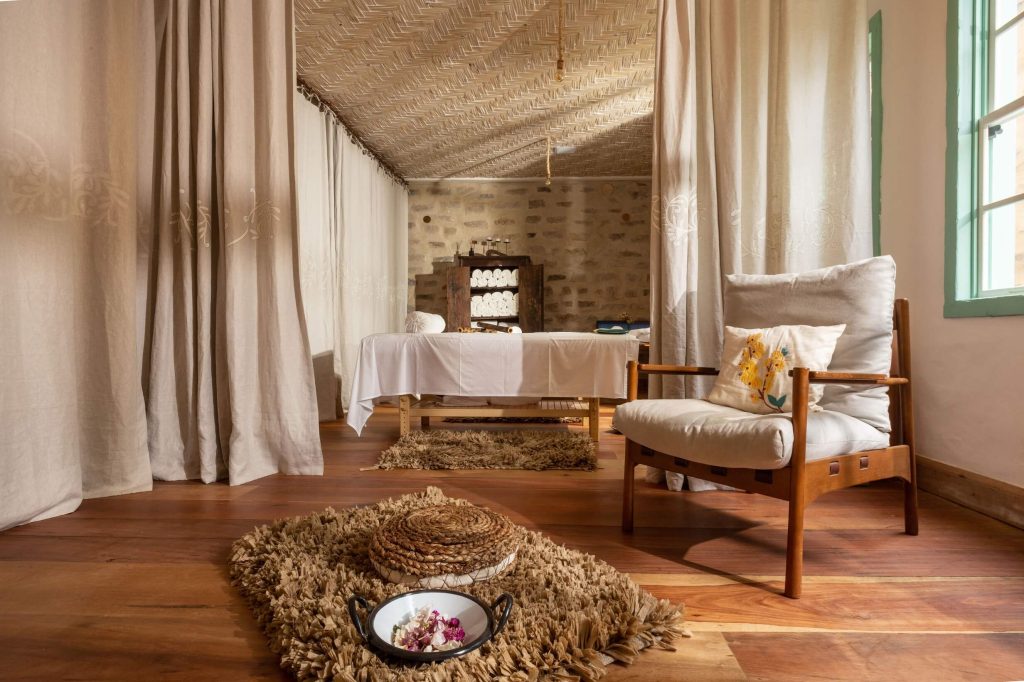
Yoga, massages and therapies: a caring touch for the skin and the soul Taking care of your body, mind and spirit is part of one of the most regenerative experiences you can have at Ibiti! Starting with the restorative morning yoga practice, included in the daily rate, which connects you to nature. Classes take place in peaceful and beautiful surroundings, such as the open room at Raízes Spa, overlooking Pico do Gavião, Prainha do Engenho, the orchid garden, the Oca and the equipped room at Spa Village, in Mogol. At the end of the afternoon, after your walks, or in the morning, you can surrender to the skilled hands of one of the massage therapists. "What makes our massages even more special are the elements from the mineral and plant kingdoms that we use as therapeutic resources, such as the pebbles taken from the local waterfalls and the bamboos that we harvest and prepare. There's also the scent of the oils, the high-vibration music and the natural teas. It's an experience that involves all the senses," says Rosana Habiba, from Spa Village. Another option is watsu, a technique derived from shiatsu, performed in a heated pool, providing deep relaxation and the opportunity to connect with one's own essence and the power of the body. "An experience of self-regeneration, accessible to anyone and totally personalized," says specialist Raisa Cotta. "We offer the Healing Day program, which lasts a whole day and includes yoga, meditation, a rustic sauna and a massage at Prainha do Engenho," suggests Andressa Jacob, from Raízes Spa. And there are specific therapies, such as the Semear Ritual, with a clay facial mask and honey body massage. The Coragem (Courage) includes two and a half hours of therapeutic procedures, with deeper care and exfoliation with ground coffee, brown sugar and coconut oil. "We finish with a bath with aniseed and cloves and a massage with hot stones." When you visit Ibiti, allow yourself this pampering and experience a complete and exclusive immersion!
Ibiti’s Minas Gerais cuisine: Dishes from the land and full of stories
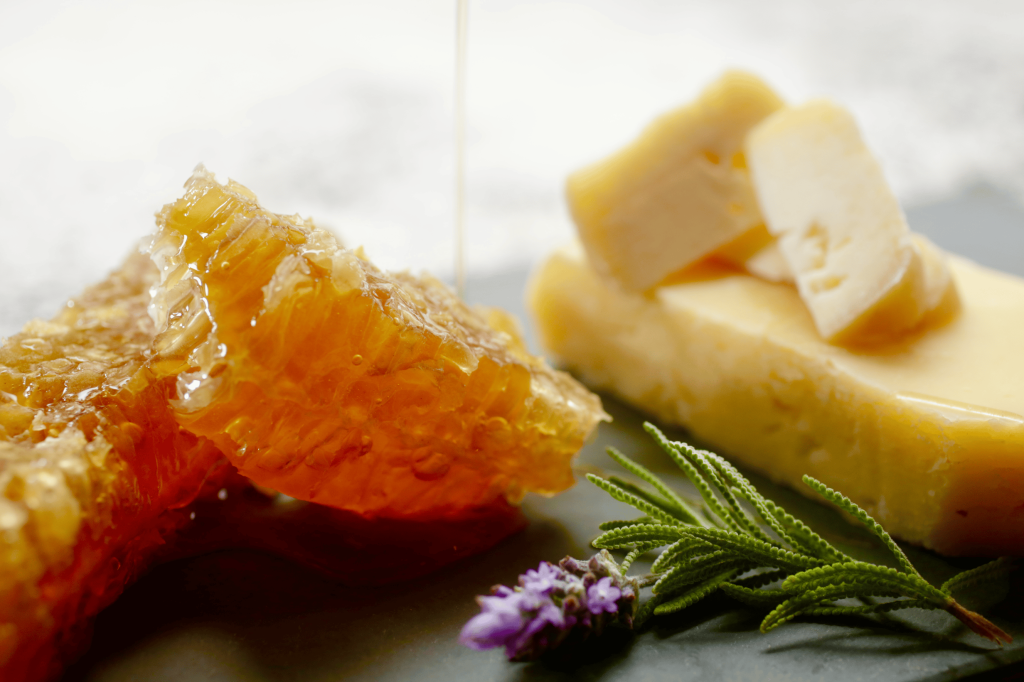
Ibiti invites you to try fresh, local ingredients Ibiti's Minas Gerais cuisine dates back to the Gold Cycle. Starting with the unparalleled taste of that homemade comfort food prepared by the locals in the Areião restaurant, with a deck overlooking the sea of hills and a recently renovated, elegant and cozy room with glass windows. There, high up in the air, Dona Maria runs the wood-burning stove, where the potted meat, the free-range chicken, the braised vegetables come from... And there's no shortage of sweets and delicacies from the mountains. Minas Gerais cuisine in Ibiti Minas Gerais takes on a more refined feel in the restaurant at Engenho Lodge, a large house reminiscent of old farms. The freshly baked cheese bread is the most popular breakfast delicacy, alongside the traditional cinnamon bread from Ibitipoca. In the evening, the menu is inspired by the cuisine of chefs such as Claude Troisgros and Pablo Oazen, produced by hands from Minas Gerais, which include affection and a little cheese wherever you can get it. PANCs (unconventional food plants) and the fruit of the juçara palm, typical of the region's forests, give personality to dishes at the vegetarian restaurant Yucca, which stands out in Ibiti Village for its beds of edible flowers at the entrance, the passion fruit covering on the outdoor tables and the vegetable garden of leaves and spices. It's about seeing and tasting real farm-to-table cuisine.
Congado from Minas Gerais maintains tradition in Ibiti

You are enjoying the end of the afternoon with the beautiful view of Serra do Ibitipoca in front of you, when suddenly around 20 members of the congado group from Santana do Garambéu enter, singing and dancing.
Accommodation in Ibiti: Discover the minimalist lofts in Baixo Mogol
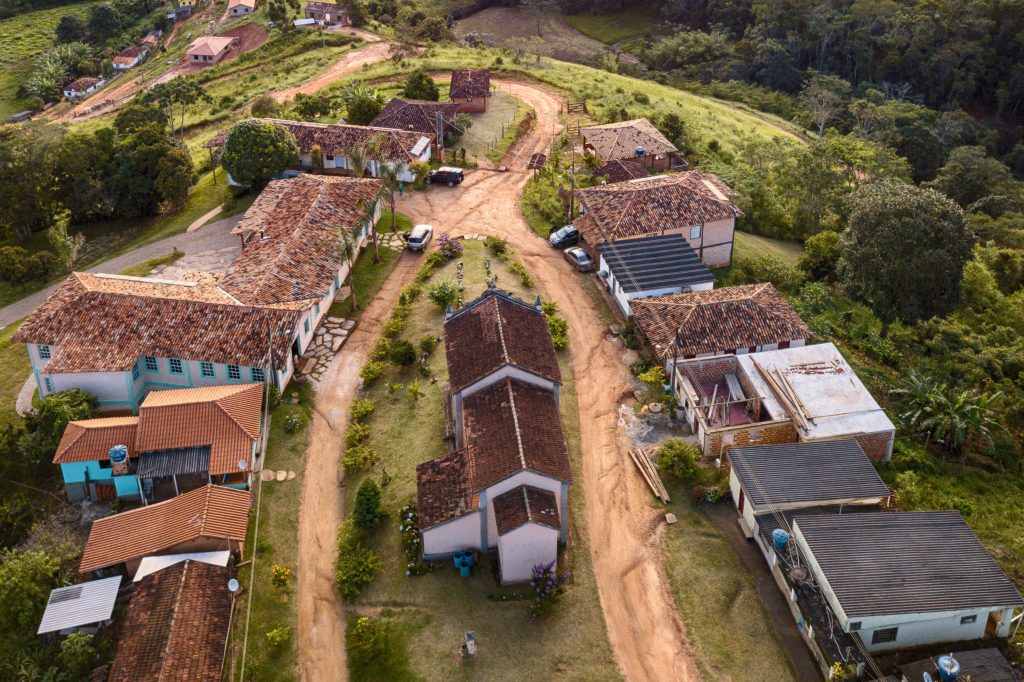
New houses and lofts have been given names and invite you to immerse yourself in the village's nature Those who come to the village of Mogol will always find something new. In the direction of the beach, four sustainable lodging options are part of Baixo Mogol, in addition to Casa Buda. They are the Ana Primavesi House and three lofts built with noble wood, acquired from demolition, such as cedar, ipê and cinnamon. Each with its own particularities, the lofts have minimalist décor, large glass windows overlooking nature and are named after names that have made history: Confucius, Douglas Tompkins and John Muir. An invitation to contemplation, to find balance and a deep connection with nature. The water is treated sustainably using lilies and banana trees, which act as natural filters.Want to know more? Come and visit Baixo Mogol! About the honorees Buddha Symbol of wisdom and spiritual enlightenment, Buddha represents the path to inner peace and harmony with nature. Ana Primavesi One of Brazil's leading agronomists, Ana Primavesi was a pioneer in agroecology, dedicating her life to soil preservation and sustainable agriculture. Confucius Chinese philosopher Confucius is known for his lessons on ethics, morality and governance. Douglas Tompkins Businessman and environmentalist, Douglas Tompkins co-founded brands such as The North Face and Esprit, and dedicated his life to preserving vast natural areas in South America. John Muir Naturalist and writer John Muir was one of the first advocates of nature conservation in the United States and played a key role in the creation of national parks.
Home of knowledge: Communiversity with a new look
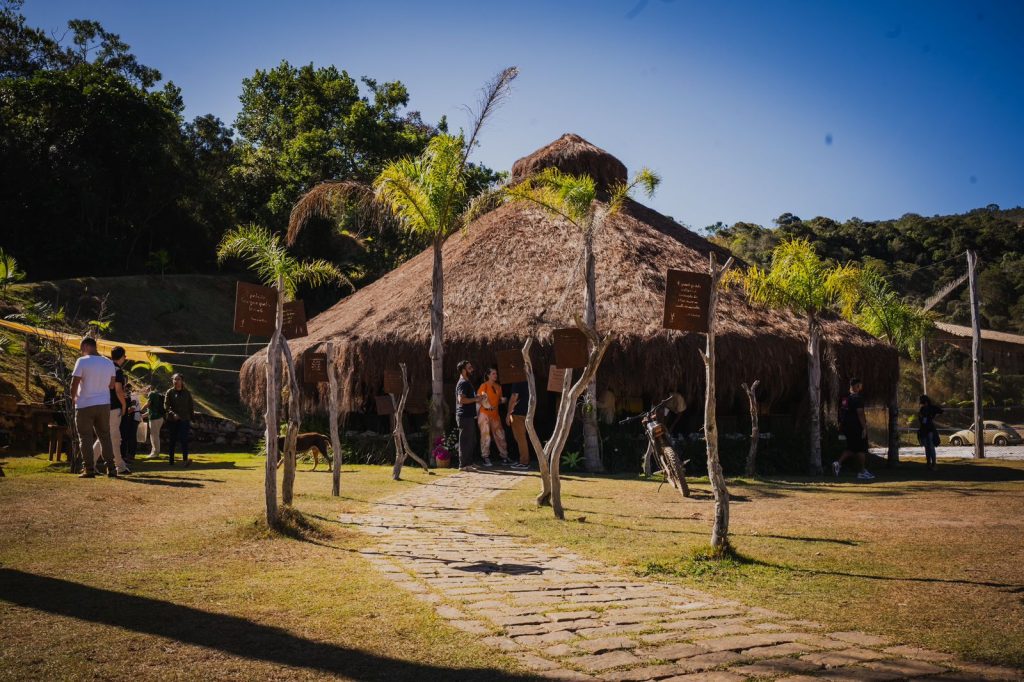
An open space for presenting, debating and hosting the most diverse artistic expressions In a circular format with a piassava roof, the space has the structure to host lectures, meetings, workshops and cultural presentations, with capacity for up to 80 people. On the walls, a warning about what the planet is suffering as a result of global warming prompts reflections on our daily actions towards ourselves, others and nature. Book this place for your next event! +55 (32) 99843-4099
Ibiti Arraiá livens up the mountains with forró rhythm
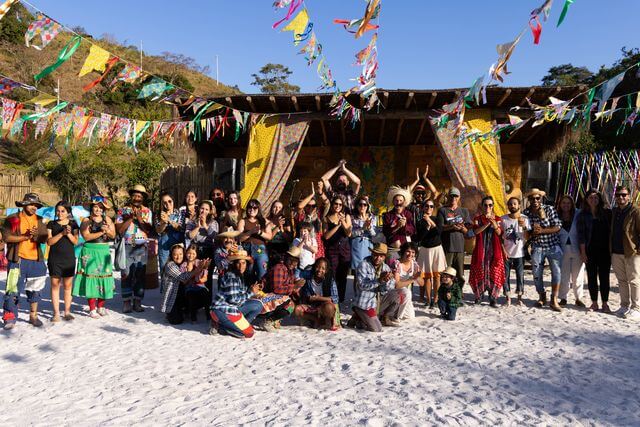
Mogol's most patched caipira costume, won by Francislei, has a message about recycling and kindness It wasn't just any Festa Junina. There were typical foods from chef Mateus. And much more! There was fishing, flags waving in the blue sky, a bonfire at the edge of the stream. And much more! There was a band playing forró and even an expert in traditional festivities commanding the dance and quadrilles of the adults and the Life School class in the middle of the white sands of Praia do Mogol. There was much more! Take a look at the photos to see what I'm talking about! If you're celebrating, there's no shortage of fun, style and whimsical country costumes! Even more so with some great prizes, which really got everyone going this year. It was the Ibiti Arraiá Most Mended Costume Contest that stimulated creativity. And the Ibiti community did a lot before, during and after the parade! There was Igor, from the horses, arriving with a berrante, Tati, from Dona Odete, with her hair standing on end and her whole family in character, the other Tati, from Mogol, drawing applause for her relaxed parade, Thiaguinho imitating a pinguço, Miguelzinho carrying manioc on the back of his inseparable bicycle, this time an old model... and many more people in costumes, smiles and willingness to shake their hips. When it came to choosing, it was quite difficult, but the popular vote left no doubt, taking into account the criteria as well, right? 1st Place: Francislei ar-ra-sou! with his shirt all patched up with scraps sewn by his wife - and with Ibiti details applied. 2nd place: Jorge danced all afternoon with his pack in his pocket, playing a legitimate jeca! 3rd place: Bárbara with her braids, a "tattoo" of little flags on her shins and the Church of Mogol embroidered on her blouse with recycled material, with every detail taken care of! There's more next year! Get your clothes mended, will you? The costumes from this first edition of the competition will become paintings to decorate the village! 1st Place Francislei, from Maintenance, has been working in Ibiti for five years and enlisted the help of his seamstress wife to make his shirt out of 183 different scraps that would have gone to waste. As well as the clothes, he also wrote a calango (sung verses) especially for the parade: 2nd Place Jorge, a construction foreman "I created the character, I like this jeitim, being a jeca" 3rd Place Bárbara, who is part of Ibiti's marketing team "I had my mother-in-law's help in creating it" Miguel Giovaninni, with his bicycle from the countryside Igor paraded with a berrante Tati and the whole family in character
Environmental project in Ibiti: Artificial reproduction in wild animals

Endangered species: Pioneering action brings artificial reproduction techniques to save muriquis Once again, Ibiti Projeto is demonstrating its efforts and great concern for preserving biodiversity by investing in an unprecedented artificial reproduction project with northern muriquis, the largest primates in the Americas, which are critically endangered. A great challenge that has only just begun. In July, a team of biologists, veterinarians and other specialists joined the Muriqui Biodiversity Institute (MIB), totaling 24 professionals, to carry out the first stage of this process with the animals that live at Muriqui House in Ibiti. "We collected and stored the semen from the two males, Bertolino and Luna, using advanced technology already applied to farm animals, and carried out a complete check-up on the three females of reproductive age - Socorro, Nena and Ecológica - who are healthy and able to receive assisted insemination or an in vitro fertilized embryo," explains Fernanda Tabacow, coordinator of the MIB. "Our optimistic expectation is to have a pregnant female in two years' time if all goes well," she says. This joint effort involves partnerships with the federal universities of Viçosa (MG) and Campo Grande (MS), the NGO Reprocom (which specializes in reproducing wild mammals to save endangered species), with financial support from Ibiti Projeto and Funbio. "What we're doing today is better understanding the biology of these animals and being able to reactivate the process of reproduction and the birth of new cubs, so that the group grows and we can achieve the ultimate goal, which is to reintroduce them into the wild. This is pioneering work and an important step in the development of studies on artificial reproduction in wild animals," says biologist Fabiano Melo, an advisor to the MIB and a professor at UFV. The northern muriquis today live in fragmented Atlantic Forest in Minas Gerais and Espírito Santos, with a population reduced to less than a thousand individuals in total. The muriquis at Ibiti underwent blood tests, imaging tests and other tests for a complete health assessment.
Financial Times

A remote village north of Rio is the focus of a tourism initiative that supports the community and wildlife
Suitcase Magazine
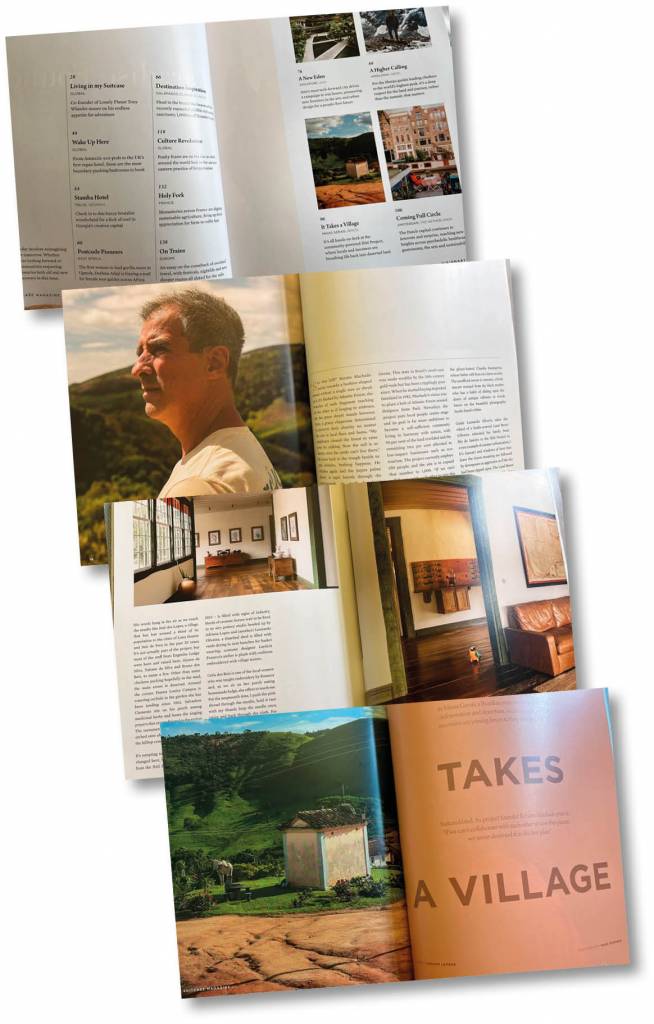
The article "It takes a village" in Suitcase Magazine, written by Imogen Lepere, with photos by Mark Rammers, who visited the project in February 2023, puts the region's past and present into context, recognizing the initiative's potential as a socio-environmental project and regenerative tourism destination. "This state in the southeast of Brazil became rich with the gold rush in the 18th century, but since then it has been extremely poor. When Renato Machado started buying up degraded farmland in 1982, his vision was to plant a belt of Atlantic Forest around the Ibitipoca State Park. Today, the project puts local people at the center of attention, and its goal is far more ambitious: to become a self-sufficient community in harmony with nature, with 98% of the land rehabilitated and the remaining 2% earmarked for low-impact businesses such as ecotourism. Currently, the project employs 350 people and the goal is to increase that number to 1,000. 'If we can't collaborate with each other to save this planet, we'll never deserve it,' says Machado."
Le Figaro
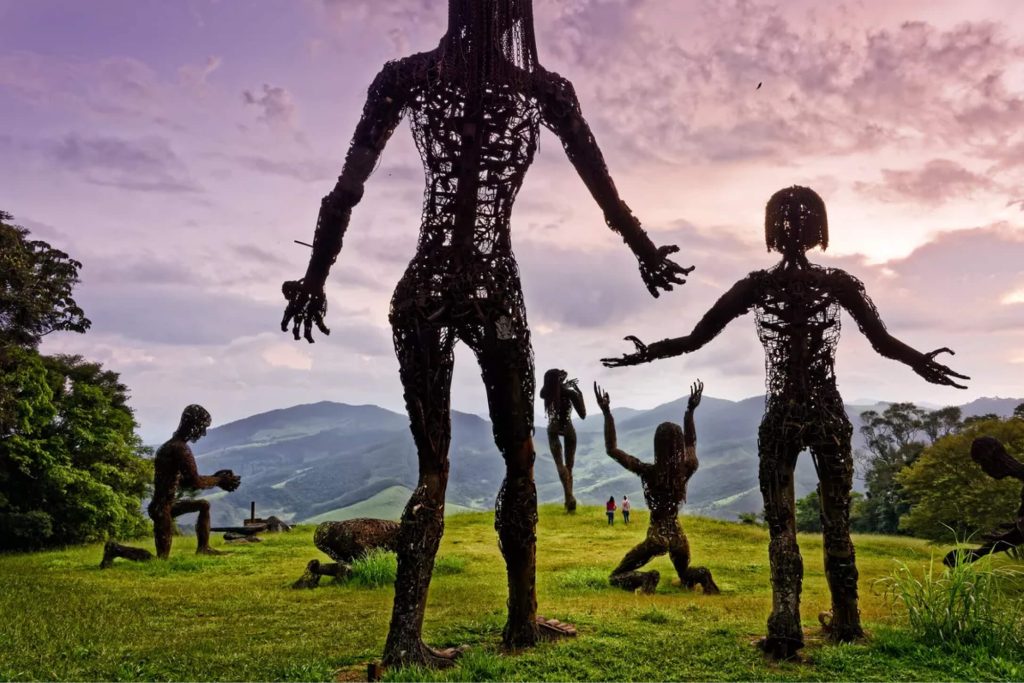
In 2022, Ibiti made the pages of the respected French newspaper "Le Figaro", with an article by Bérénice Debras (and photos by Érik Martin), which covered the art and nature of the mining project. "Far from the noise of the world, time stretches delightfully to the rhythm of hammock swings or walks, bike rides or horseback rides on the property, leading to festive meals prepared along the waterfalls. (...) 'Ibiti is a simple project that asks fundamental questions,' observes Renato Machado. 'Where do we place our values today? Are gold or diamonds worth more than the destruction of nature for their extraction? (...) Now, I let nature do its work for more biodiversity." Read the original article